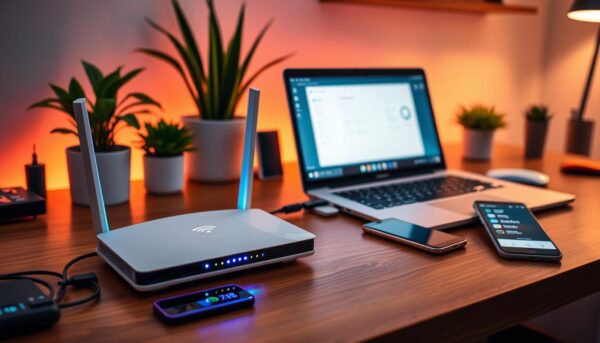✅ Last checked on
When you’re online, you might face issues like slow WiFi, connection problems, or dropped signals. These can mess up your work and fun online. To fix these, you can check out tips to boost your WiFi. About 54% of people deal with slow WiFi, and 75% of homes have connection drops because of interference or too many devices.
To tackle these WiFi issues, first, check your router’s settings. Make sure it’s in the middle of your home and update its software often. Not updating your router’s software can cause problems and make your network less secure. By doing these things, you can make your WiFi faster and more reliable.
Key Takeaways
- You can experience common WiFi problems such as slow WiFi speed and WiFi connectivity issues.
- Approximately 54% of users encounter slow WiFi connections, while 75% of households face intermittent connection drops.
- Updating your router’s firmware and ensuring it is centrally located can help resolve common WiFi problems.
- Using WiFi extenders can improve coverage by as much as 50% in areas previously deemed dead zones.
- Regularly checking your network settings and device connections can help prevent common WiFi problems.
- Implementing WPA2 or WPA3 encryption can reduce unauthorized access to your network by up to 70%.
- Restarting your router can resolve WiFi issues, with 95% of connectivity issues resolved by simply rebooting or resetting network devices.
Understanding Common WiFi Problems and Their Root Causes
WiFi issues often come from a mix of reasons. Network interference, Router problems, and weak signals are common. Let’s look at each one.
Devices like microwaves and cordless phones can mess with WiFi. So can walls and floors. Router setup mistakes can also cause problems. Weak signals can make your internet slow.
Types of WiFi Interference
There are a few kinds of WiFi interference. Co-channel interference (CCI) happens when many access points use the same channel. This slows things down. Adjacent channel interference (ACI) occurs when nearby networks use channels that overlap, causing trouble.
Hardware vs. Software Issues
Old router firmware or physical damage can hurt WiFi. Software problems, like wrong Router settings, can also cause issues. Keeping your router’s firmware up to date and checking for software updates can help.
Environmental Factors Affecting WiFi
Things like nearby networks can weaken WiFi signals. Non-WiFi devices, like Bluetooth, can also get in the way. Knowing these can help you make your WiFi better.
Understanding WiFi problems can help you fix them. Regular updates, the right Router settings, and less interference can make your WiFi faster and more reliable.
| Issue | Cause | Solution |
|---|---|---|
| Slow internet speeds | Network interference, Router configuration problems | Update router firmware, optimize Router configuration |
| Connectivity issues | Signal strength problems, hardware issues | Check for software updates, replace outdated hardware |
Slow Internet Connection: Causes and Solutions
Slow internet can be really frustrating, making it hard to get things done. It’s often due to network congestion and activities that use a lot of bandwidth. Finding out why your internet is slow is key to making it faster.
Slow internet can come from damaged cables, weak WiFi signals, or other devices causing interference. Also, having many devices on the same network can slow things down. Try moving your router to a better spot, getting a new router, or using a mesh system to fix this.

To avoid slow WiFi, watch your internet use and try to avoid heavy activities when lots of people are online. Use Quality of Service (QoS) settings to make sure important activities get more bandwidth. This helps keep your internet fast and reliable.
| Cause of Slow Internet | Solution |
|---|---|
| Network Congestion | Upgrade to a dual-band or tri-band router |
| Weak WiFi Signal | Relocate the router to a central location |
| Bandwidth-Intensive Activities | Use QoS settings to prioritize online activities |
Understanding why your internet is slow and fixing it can make a big difference. Keep an eye on your internet use and tweak your settings to avoid slow speeds and congestion.
WiFi Signal Strength Issues and Dead Zones
There are many reasons for weak WiFi signals. Distance, physical barriers, and other device interference are common culprits. To boost your WiFi, place your router wisely and think about using WiFi extenders or Mesh systems.
Dead zones often come from thick walls, heavy metal furniture, and other devices like baby monitors. The 2.4 GHz band reaches farther and works better through walls than the 5 GHz band. Many routers also send out less than full strength to keep outsiders out, which can cause signal drops in big homes.
Optimizing WiFi Signal Strength
To get a stronger WiFi signal, try these tips:
- Put your router in the middle of your home to avoid obstacles
- Use WiFi extenders or Mesh systems to cover more area
- Switch to the 2.4 GHz band for better range and wall penetration
By using these strategies and the right gear, you can strengthen your WiFi and get rid of dead spots. WiFi extenders and Mesh systems are great for big homes or places with lots of walls. With the right setup, you’ll have fast and reliable WiFi everywhere in your home.
| Frequency Band | Range and Penetration |
|---|---|
| 2.4 GHz | Longer range, better penetration |
| 5 GHz | Faster, but less effective at penetrating walls |
Router Configuration and Network Settings
To have a reliable WiFi network, setting up your router right is key. Problems with router setup can stop your WiFi from showing up. Also, wrong network settings can make your WiFi not secure. You can make your WiFi safer by using strong passwords and turning on WPA2 or WPA3 encryption.
Some important things to think about for router setup and network settings are:
- Proper router placement to improve WiFi signal strength
- Configuring network settings to accommodate multiple devices
- Enabling WiFi security features, such as WPA2 or WPA3 encryption
Restarting your modem and router often can fix common connection problems. Also, checking physical connections and testing different websites can help find the source of issues. By following these tips, you can make sure your WiFi is both stable and secure.

| Issue | Solution |
|---|---|
| Router configuration problems | Proper configuration and regular restarts |
| Network strain | Upgrading your internet plan to accommodate multiple devices |
| WiFi security issues | Enabling WPA2 or WPA3 encryption and using strong passwords |
Device Connectivity Problems and Troubleshooting
When you face device connectivity issues, finding the main problem is key. Connection drops can be really annoying, like when you’re in the middle of something important. Also, sometimes your device can’t find the network, which is a big problem.
To fix these problems, start by restarting your device and looking at your network settings. Make sure you’re using the right network password. Also, check if your device works well with your network. Sometimes, IP address conflicts can cause issues, so it’s good to check those too.
- Incorrect network passwords
- Device compatibility issues
- IP address conflicts
By finding and fixing these problems, you can get your device to connect better. Also, using Quality of Service (QoS) settings can help make sure your device gets the best connection. This can stop connection drops.
Places with lots of WiFi, like apartments, can have WiFi congestion. This means lots of networks competing for the same space. This can cause problems like connection drops and devices not finding the network. Knowing why these issues happen helps you find ways to fix them and get a stable WiFi connection.
Security Issues and Network Protection
When you’re making your WiFi network better, think about security too. It’s key to keep your WiFi safe from unwanted access. Use strong passwords, turn on WPA2 or WPA3 encryption, and create a guest network. These steps help a lot in keeping your network safe from threats.
Keeping your encryption up to date is also important for security. Make your SSID hard to guess to avoid Evil Twin attacks. Use wireless security software for network scans and to find weak spots. This way, your WiFi network stays safe and secure.
To really protect your WiFi, think about using Firewall settings. This is very important for businesses or anyone with sensitive info. With strong passwords, encryption, and Firewalls, you can make a strong defense for your network.
| Encryption Protocol | Security Level |
|---|---|
| WEP | Low |
| WPA | Medium |
| WPA2 | High |
| WPA3 | Very High |
Knowing about encryption protocols helps you protect your WiFi. Always use strong passwords, enable WPA2 or WPA3, and have a guest network. This way, your network stays safe and secure.
Advanced Troubleshooting Techniques
Dealing with complex WiFi issues can be tough. Advanced troubleshooting techniques can save the day. Tools for network diagnostics help find and fix problems. Keeping your router’s firmware updated is also key for a stable connection.
Common advanced techniques include using network diagnostics tools and updating router firmware. You can also tweak DNS settings to boost network performance. These steps can solve many WiFi issues.
Network Diagnostics Tools
Network diagnostics tools are great for spotting and fixing connectivity issues. They offer insights into your network’s health. With these tools, you can quickly solve problems and keep your network running smoothly.
Router Firmware Updates
Updating your router’s firmware is crucial for a stable connection. Firmware updates bring security patches, performance boosts, and new features. Keeping your firmware current ensures your router works well and securely.
DNS Configuration Solutions
DNS configuration can enhance your network’s speed and reliability. By adjusting your DNS settings, you can make your network faster and more reliable. This is very helpful for businesses or anyone who needs a reliable network.
| Troubleshooting Technique | Description |
|---|---|
| Network Diagnostics Tools | Identify and fix connectivity issues |
| Router Firmware Updates | Provide security patches, improve performance, and add new features |
| DNS Configuration Solutions | Improve network performance and reliability |
Conclusion: Maintaining a Reliable WiFi Network
To keep your WiFi network working well, it’s key to stay on top of maintenance. Make sure to update your router’s firmware often. This helps fix security problems and improves performance.
Using Quality of Service (QoS) settings is also important. It helps make sure important network traffic gets priority. This means you can stream, game, and video call without interruptions.
Keep an eye on how your network is doing and fix any issues quickly. Being proactive with your network helps you enjoy a smooth WiFi experience. This is true even as your needs change over time.